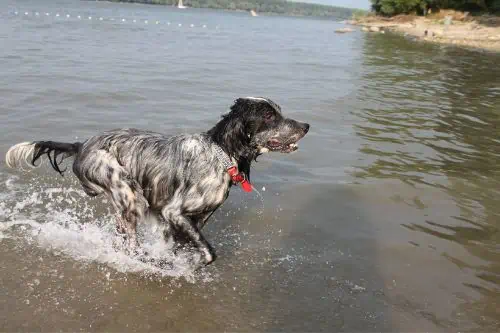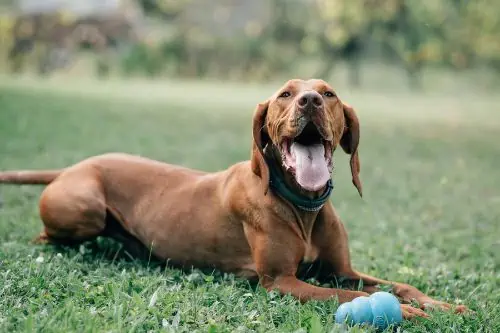Vizsla vs German Shorthaired Pointer What’s the Difference
In the world, there are many dog breeds that have different personalities and features. Each of them is different in color, physical appearance, personality, behavior, and abilities.
The Vizsla and the German Shorthaired Pointer are two breeds that have certain similarities, but each of them has characteristics with different nuances.
The Vizsla is a breed that is characterized by its skills in hunting and other activities. This beautiful animal has an elegant appearance that makes it stand out among many types of dogs.
On the other hand, the German Shorthaired Pointer is one of the most energetic animals among the breeds that are dedicated to hunting. It is a dog with an impressive physical build that allows it to have excellent athletic qualities.
Related Reading: Vizsla vs Braque Francais: What’s the Difference?
Vizsla vs German Shorthaired Pointer Comparison Table
| About | Vizsla | GSP |
| Weight | 40-65 lbs | 45-70 lbs |
| Height | 21-25 inches | 21-25 inches |
| Life expectancy | 12-15 years | 12-14 years |
Next, you will be able to know the differences and similarities that these two dog breeds present:
Differences Between Vizsla and GSP
Physical Features
The Vizslas are elegant and athletic dogs that are characterized by having muscular and well-proportioned bodies. As a puppy, they both have similar features and are similar sizes as well.
Male Vizslas are large in size ranging from 58 cm to 64 cm in height, while female ones are between 54 cm to 60 cm.
The weight of these canines also depends on their sex. In the case of the male ones, they can weigh from 22 kg to 32 kg while the female ones between 20 kg and 30 kg.
As for the physical characteristics of the head of this type of dog, they have a thin head but a broad and robust skull. It has a pronounced nose, dark-colored oval and medium eyes (usually brown), and medium-sized hanging ears.
This dog’s tail is long, thick at the base and thin at the other end. The Vizslas have beautiful thick, short, dense fur that protects them in cold weather. Its coat is golden yellow.
The German Shorthaired Pointer has a tall, muscular, and well-proportioned body with a strong back and good musculature.

The height of the canine is between 62 cm and 66 cm for a male GSP, while the female ones can measure between 58 cm and 66 cm. The German shorthaired pointer male weighs between 25 kg and 31 kg while the opposite sex between 20 kg and 27 kg.
This breed features an elongated head and medium-dark eyes (generally brown like the Vizslas). Its long ears are slightly bent and hanging. The skull of this type of dog is wide and proportionate.
The tail reaches typically as far as the hock when hanging, and remains steady when the dog is performing an action.
The German Shorthaired Pointer is a short-haired breed with a rough and hard coat that can have different color patterns in which the color brown prevails.
Personality
Vizsla dogs are active and energetic and need to be in constant physical movement. When you have a Vizsla puppy, they still tend to have a lot of energy and love running and moving around.
That is because it is a dog specialized in hunting activities, so it is essential that it performs physical exercises every day (at least 1 hour per day).
It means that it is not a good idea to leave these canines confined inside a house for a long time as they become anxious and destructive, trying to release all the energy that they had accumulated.
Furthermore, these dogs are very intelligent and teachable. Vizslas like to be trained to improve their skills during hunting and other activities.
It should be noted that this type of canine is friendly and affectionate to members of its human family, children, strangers, and other animals.
It can practically be loving to everyone; however, if it notices that its family members are in danger so it may adopt protective behavior.
We must make it clear that the Vizslas are not aggressive. On the contrary, they are animals that need love, and any verbal aggression towards them could affect them emotionally.
Like the Vizslas, the German shorthaired pointer is also very active and is characterized by being one of the best hunting breeds.
They need to spend much of their time outside touring the field or exploring. They are very loving and playful with their human family members, including children, which makes them perfect to be part of any family.
These dogs are brilliant and teachable, just like the Vizslas. They need to do outdoor activities, preferably accompanied by their loved ones. These canines were born to live with families that live in open places like a field or a house with a large garden.
They tend to be friendly to anyone, including strangers, as well as other animals. However, it is essential that a dog of this type has been trained from a young age in terms of socialization.
If its owner keeps it confined within a small space, it can become destructive as a way of acting out. That occurs because they try to release all their energy since they need to always move.
Care and Maintenance

The care that a Vizsla breed must have is basic but equally important. It is vital that the owners of these dogs develop an exercise routine according to the age and size of their Vizsla.
A puppy should not do the same amount of exercise as an adult dog. Similarly, properly feeding this type of pet is essential to ensure the health of this breed.
Its coat does not require much care since it is short and thick. It will only need to be cleaned when the dog is dirty. It should be noted that, like other animals, these canines must be dewormed and vaccinated when required to reinforce their health.
Unlike the Vizsla, the German shorthaired pointer loses hair regularly, so its coat needs to be brushed 2 to 3 times a week.
However, it does not require much effort. It is only necessary to bathe this dog when it is dirty, which may depend on the amount of time it is used in hunting activities.
Similarly, they are dogs that need to live in open spaces to carry out physical activities every day.
Related Reading: Vizsla vs Papillon: What is the Difference?
Which Dog Breed is Better For First Time Owners?
Both dog breeds are hunting dogs and can be tough to train and manage for first-time dog owners. They have a similar temperament and require a lot of exercise and training to keep in order.
Most people would be better off with a shorthaired pointer over a Vizsla because they can be easier to train and control for less experienced owners.
They do have a ton of energy so you have to be prepared for that. You’re also more likely to find a GSP breeder in most states instead of a breeder for Vizslas.
Vizslas tend to be more expensive and harder to find in general when compared to German Shorthaired Pointers.
Vizslas also require an owner that will be around most of the time, as they get more emotionally attached and want to be by the owner’s side.
Separation anxiety is one thing that you would have to worry about if you tend to be gone for long periods of time with a Vizsla.
Are Vizslas Calmer Than GSP?
Vizslas tend to be slightly calmer than German Shorthaired Pointers, although they are more emotional and require closer care.
Since they are hunting dogs, both breeds require a good amount of exercise and mental stimulation otherwise they can start causing trouble around the house.
But, Vizslas can be considered velcro dogs, where they love being at your side and following you around all over the place.
Are GSP Velcro Dogs?
German Shorthaired Pointers are affectionate, and lovable, and love to show it by cuddling up to their owner. They are more independent than other breeds, but they will follow you around when they’re feeling up for it.
Many people do consider them velcro dogs because they like to be close and stay close most of the time.

Family Dog Expert Author
Hi there! I’m Stuart, a devoted dog lover and family dog expert with over a decade of experience working with our furry companions. My passion for dogs drives me to share my knowledge and expertise, helping families build strong, loving bonds with their four-legged friends. When I’m not writing for SirDoggie, you’ll find me hiking, playing with my beautiful dog, or studying music.